
TẠP CHÍ KHOA HỌC VÀ CÔNG NGHỆ, Trường Đại học Khoa học, ĐH Huế
Tập 23, Số 1 (2023)
125
SOFTWARE – HARDWARE CODESIGN FOR RECONFIGURABLE
CONVOLUTIONAL NEURAL NETWORK ACCELERATION
Nguyen Duc Nhat Quang1*, Nguyen Thanh Binh2, Pham Thi Thuy Sang3
1 Faculty of Electrics, Electronics Engineering and Material Technology,
University of Sciences, Hue University
2 Office for Financial Planning & Facilities, University of Sciences, Hue University
3 Hue Center of Information and Technology
*Email: ndnquang@hueuni.edu.vn
Received: 17/8/2023; Received in revised form: 21/8/2023; Accepted: 4/12/2023
ABSTRACT
Convolutional neural network (CNN) is widely used in many areas such as image
recognition, object detection, and self-driving cars and it requires a huge amount of
computation and memory usage when the number of layers increases. Hence, it is
critical to reduce its computational complexity and memory usage. In this paper,
author uses 8-bit fixed-point quantization to greatly reduce the memory space
requirement of the feature maps and weights and the accuracy of LeNet-5 with
MNIST dataset is only slightly reduced. In the hardware accelerator, author
proposes a highly flexible CNN accelerator with reconfigurable layers. The layers
contain padding, convolution, ReLU, max-pooling and flatten operations, and they
are reconfigurable. The advantage of the proposed method is that by reusing layers
or circuits, it is possible to reduce hardware resources.
Keywords: artificial intelligence (AI), convolutional neural network (CNN), IC
design, software-hardware codesign, reconfigurable.
1. INTRODUCTION
In recent years, Deep Learning Neural Network (DNN) has become increasingly
popular, and there are many kinds of DNN. One popular and well-known DNN model
is Convolutional Neural Network (CNN). CNN keeps the advantage of the Artificial
Neural Network (ANN) and uses a massive network of neurons and synapses to
automatically extract features from data. It has been extensively adopted in various
applications owing to the high accuracy, such as image classification, object detection,
speech recognition, visual question answering, semantic segmentation, and self-driving

Software – hardware codesign for reconfigurable convolutional neural network acceleration
126
cars. With sufficient training data and highly complex and flexible feature extraction,
CNN performs higher accuracy than traditional image processing methods in the above
applications.
As the application of CNNs becomes more complex and more accurate, the
number of layers and computation required are also increasing. For example, the CNN
models along with more than a hundred layers, such as ResNet101 [1] and DenseNet121
[2] require a considerable amount of computing resources and memory space. Therefore,
it is critical to reduce the computational complexity and memory usage of CNN.
To address this problem, many researchers have proposed various CNN
inference process acceleration techniques. In order to improve computation efficiency,
accelerators in FPGA and ASIC platforms have been proposed while GPU has a low
energy efficiency despite powerful performance.
However, since FPGA and ASIC have limited on-chip memory capacity and
limited off-chip memory bandwidth, it is necessary to reduce the memory usage. To
tackle this problem, fixed-point data quantization is a good way to relieve the memory
capacity and bandwidth pressure. Fixed-point data quantization means using shorter
fix-point number representation of weights and/or data values to represent floating-
point ones in the original system. Implementing fixed-point arithmetic units on FPGA is
much more efficient compared with floating-point number representations. It will
significantly reduce the requirement of both on-chip memory capacity and off-chip
memory bandwidth. Consequently, most of the previous CNN accelerators have been
making use of fixed-point numbers instead of floating-point numbers [3][4][5].
Smaller neural networks are more feasible to deploy on FPGAs and other
hardware with limited memory. Layer reuse is the technique that CNN layers are used
repeatedly without the need for introducing new layers to obtain the smaller network.
The layer must be reconfigurable to reuse with different input and output shapes [6].
More and more CNN accelerators are built mostly using group convolutional layers to
greatly reduce computation cost while maintaining accuracy [7][8][9]. However, CNN
contains many types of layer and it is possible to reuse in the same network.
Therefore, in this work, we propose a novel CNN accelerator design with
reconfigurable layers. The feature maps and weight are quantized with the 8-bit fixed-
point format. The contributions of this work are summarized as follows:
• We use 8-bit fixed-point to save memory usage but remain the accuracy.
• We propose a CNN accelerator, which contains padding, convolution, Rectified
Linear Unit (ReLU) [10], max-pooling and flatten operations.

TẠP CHÍ KHOA HỌC VÀ CÔNG NGHỆ, Trường Đại học Khoa học, ĐH Huế
Tập 23, Số 1 (2023)
127
• The convolution layer, max-pooling layer and flatten layer are reconfigurable. It
is able to perform convolutional operations, max-pooling or flatten operations
respectively. A system must be flexible enough to execute different neural
network models. To achieve this, a flexible description is necessary.
2. CNN MODEL SELECTION AND DATA QUANTIZATION
This section first describes the overview of our workflow. Then it presents the
CNN model used in this work and describes the fixed-point quantization used in this
work.
2.1. Workflow overview
Figure 1 shows the flow of our work. The flow includes the software simulation
and hardware platform.
Model
configurations
Model training
Fixed-point
quantization
Quantized
parameters
Quantized
input
Output result
Hardware CNN
accelerator
Parameter
Testing data
Traning data
Hardware platformSoftware simulation
Figure 1. Workflow overview.
The purpose of the software simulation is to prepare the parameters that are
needed for hardware design. In the software simulation, a CNN model is selected,
trained, and quantized. First, the CNN model which is suitable for implementation in
hardware CNN accelerator is selected. The configurations of the model such as the
number of layers and the filter size of each layer are generated. Then, the model is trained
on the server with the GPU to get the model parameters. Finally, in order to reduce the
bit width of data in the CNN model, the input data, model parameters (including
weights and biases) are quantized so that they can be suitable for the CNN accelerator
design.
In the hardware platform, based on the model configurations and quantized
parameters, we implement the CNN hardware accelerator. After the CNN hardware
accelerator is implemented, the quantized testing data can be used to evaluate the
accuracy of the CNN hardware accelerator.

Software – hardware codesign for reconfigurable convolutional neural network acceleration
128
2.2. CNN model selection and training
First, a CNN model suitable for implementing in a CNN accelerator is selected.
Considering the hardware system and implementation, the amount of on-chip memory
is limited, and most of the data must be transferred from off-chip memory. However,
the off-chip memory data transfer time is much longer than on-chip memory. Therefore,
considering the memory issue, we decided to choose a CNN model with an insufficient
number of parameters to apply the CNN accelerator. In addition to reducing the
memory transfer time, the on-chip memory of the accelerator can also store all data for
each layer of CNN.
Based on the selection principle of the previous section, LeNet-5 [10] is selected
as the model of CNN accelerator because of the small number of parameters. The well-
known LeNet-5 based on CNN was successfully applied to character recognition. LeNet-
5 is composed of seven main layers, which are one input layer, two convolutional layers,
two pooling layers, two fully-connected layers, and one output layer, as shown in figure
2.
Figure 2. Illustration of LeNet-5 model.
Table 1 shows the configuration about LeNet-5 model. In table 1, conv2d is the
convolutional layer, max_pooling2d is the max-pooling layer, flatten is flatten layer, and
dense is the fully-connected layer. As can be seen from table 1, the total amount of
parameters in LeNet-5 is also less than 1M. Thus, we choose LeNet-5 as the model of the
CNN accelerator.
Table 1. Summary of LeNet-5 architecture.
Layer
Output Shape
Parameter #
conv2d_1
(28, 28, 16)
160
max_pooling2d_1
(14, 14, 16)
0
conv2d_2
(14, 14, 36)
5,220
max_pooling2d_2
(7, 7, 36)
0

TẠP CHÍ KHOA HỌC VÀ CÔNG NGHỆ, Trường Đại học Khoa học, ĐH Huế
Tập 23, Số 1 (2023)
129
flatten_1
(1764)
0
dense_1
(120)
211,800
dense_2
(84)
10,164
dense_3
(10)
850
Total parameters
228,194
Table 2. Accuracy comparison of different fraction point positions of 8-bit data format
in LeNet-5 model.
Integer bits
Fraction bits
Accuracy
1
7
0.976
2
6
0.980
3
5
0.984
4
4
0.988
5
3
0.980
6
2
0.884
7
1
0.168
The MNIST handwritten digit database is used for training and testing. The
LeNet-5 CNN is implemented with python language in this work, in which the floating-
point feature data and weights are used. The input data of LeNet-5 is 28x28 grayscale
images, 784 bytes in total, and the images are normalized before the convolution
operation. There is padding throughout the calculation. The ReLU serves as activation
functions. If the input of this function is x, the output is max(x, 0).
After training 20 epochs, the test is processed, and the results show that the
accuracy rate of LeNet-5 implemented in this paper is up to 99.04%, which meets the
requirement.
2.3. Data quantization
Generally, to guarantee high recognition accuracy, 32-bit floating-point data and
weights are used to train the CNN model. However, such high data precision brings
more pressure to hardware because high data precision usually requires more
computational resources and a larger memory footprint. Quantization results for
different CNN models in [11] show that 8-bit fixed-point quantization brings negligible
performance loss for several networks. In addition, the accuracy of the neural network
with more than 8-bit precision is almost equal to the floating-point. Therefore, we adopt


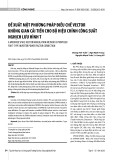
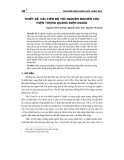
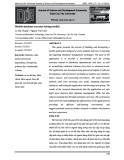



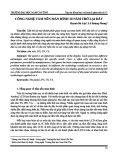
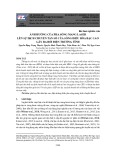
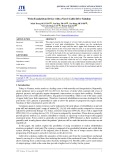

![Trắc nghiệm Mạch điện: Tổng hợp câu hỏi và bài tập [năm hiện tại]](https://cdn.tailieu.vn/images/document/thumbnail/2025/20251118/trungkiendt9/135x160/61371763448593.jpg)













